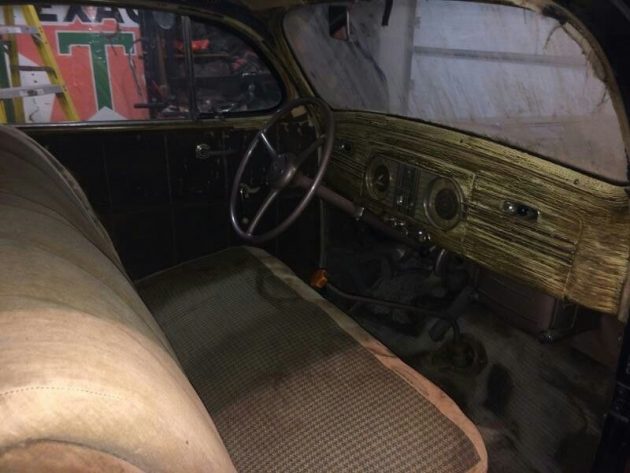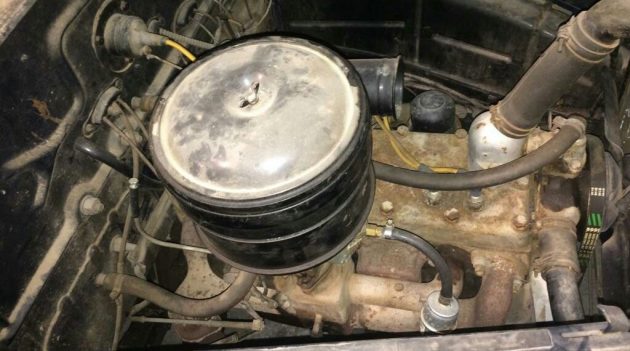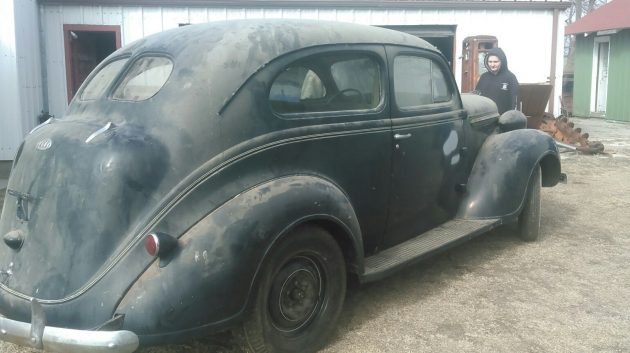The origin of the Plymouth name for these cars is interesting. Chrysler had purchased Maxwell and needed a low priced car to compete with Chevy and Ford. In 1926 the Maxwell four-cylinder was improved a bit and rebadged as the Chrysler “52”. The car needed its own name. Plymouth Binder twine was very popular with farmers, so somehow it made sense to name their new car after string. In 1928 the name was “Chrysler-Plymouth Model Q”, and in 1929, just the car was simply Plymouth. This Plymouth is listed on eBay in Kearney, Nebraska for $8,000. That is at least double what the car is worth I think. It was running a couple of years ago and the engine is not seized.
The interior looks dirty but might be usable, but it’s likely not nice under the blanket. The seller says much of the interior is in the trunk, but there doesn’t seem to be much there except perhaps the remains of the door cards. Apparently a previous owner had a mouse invasion, didn’t like the smell and removed some of the interior.
Here’s the flathead four, 170 CID with about 40 HP. It ran a couple of years ago and it’s not seized.
This seems like a great old car to save if the price was reasonable. It might not take much to make this a great driver, dents, primer and all. The dark blue paint might polish out and look really nice in some places. The interior is surely going to need to be completely redone. Perhaps this would make a good basis for someone’s hot rod. Does anyone have an idea how the mice would have caused the rust on the quarter panels as the seller says?




Waaay to nice a car to sacrifice to rodders.
but bigtime overpriced.
I sold a running unrestored 37 which needed nothing except new tie rod ends for $7K in 2009, I don’t think the market has gone up that much.
and the engine here is a 6 not a 4……
the rust on quater panels are from male mice hiking their leg when they are peeing.
The car has a great look from every angle. Agree…don’t rod it and overpriced. How about a slant 6 transplant to make it a great driver?
Cummins 4bt candidate .
Most definitely a restoration project. Far too complete to fall victim to a hot-rodder’s torch. I might be tempted to toy with a 251 to keep the Model T’s from passing me. Otherwise, a bone-stock driver restoration. Lots of fun to be had in that beast.
38 Plymouth’s ONLY came with a 6 cylinder engine. I’m putting a Slant 6 in my 38 and I have a 6″ recess in the firewall to accept the length.
This would make a great project and should be undertaken but I agree it is overpriced. For this kind of money the seller should put some effort into it. Get it running and clean it up so it shows better. I simply don’t understand this new fad of showing the dirt so people think it’s a great find. To me it says the seller is lazy and wants the world for it without the effort.
Rust around the lower edge of the vehicle is most likely the result of moisture being trapped by dust/dirt/debris in the nooks and crannies of the body.
Rodents generally prefer to occupy drier parts of the body, where they will establish living quarters, and then proceed to urinate in these areas. They seem to like the junction of the roof & body.
Other favoured places for rodent inhabitation are gas tanks and radiators. This was one of my Model A Ford gas tanks — 5 gallons of mouse nests
Is this the same Six that they used through the late ’50s? If so, it’s moderately roddable and quite sturdy, so a modest set of upgrades could turn it into a nice period hot rod without cutting it up.
What a beautiful car to work with, so complete and original.
Expensive? A little…but have you accurately priced out metal repair on rougher cars?
Someone will gladly pay a premium to save all of the time required on a rusty and less complete car.
I have a higher compression aluminum head for it, so I would look for a twin carb intake and a split exhaust manifolds. I also cannot drive stick shifts at the moment and am considering the push button 2 speed automatic transmission. I vote for a resto-mod.
These engines were rated at 80 hp,not 40. Heres one I was looking at yesterday.Im sure much,much less than 8k will buy it.
Some mice have actually learned to use certain former nesting chambers as a toilet. Moreover, that toilet chamber will hold more moisture longer than other resting areas, plus you have the issue that urine holds some corrosive chemicals in it.
It is totally plausible that this issue would accelerate the formation of rust.
Just a few cubes of that green rat poison would have stopped this from happening.
I wouldn’t be scraping that engine to quickly, they are quit bulit proof, the other thing to remember is with these old strokers hp is less important than torque. The power to the wheels is all about flywheel weight and connecting rod length. This is such a good engine design that Chrysler used it from 1938 all the way up to 1959 in there cars and all the way up to 1972 in industrial and military applications. I’m working on a 1951 dodge with vertually the same drive line and after a 23 year sleep it fired right up on a gas can fuel supply. The engine just purred, and the oil gauge showed 40 psi at idle. This old 38 Plymouth will drive down the high at 65 mph all day long with this engine.